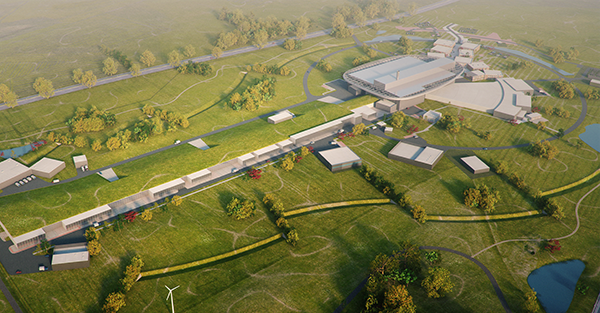
Visualisation of the European Spallation Source (ESS), a neutron source driven by a linear accelerator (Image: ESS)
In February 2017, over 70 high-energy physicists visited CERN to attend and present at a workshop on the “Status of Accelerator Driven Systems Research and Technology Development”.
Accelerator Driven Systems (ADS) refer to the use of particle accelerators in combination with subcritical nuclear reactor cores to allow fission to be sustained through the production of neutrons by spallation.
ADS have a variety of applications, ranging from the transmutation of nuclear waste, to energy generation and production of isotopes for use in cancer treatments.
The workshop, organised by WP4 of the EuCARD-2 project, focused on the following ADS-related topics: international ADS programmes, socio-economic impact of ADS, accelerator operation in ADS, coupling experiments, and future challenges for ADS research and development.
“The workshop has gathered a wide and active community, whose interest is demonstrated by the many programs that are on-going in the world. Accelerator technologies in ADS can provide important contributions to society,” said Marcello Losasso, member of the Scientific Programme Committee.
He continued: “The old cyclotron/linac opposition led to interesting discussions during the workshop. In particular, cyclotron technology was assessed as a worthwhile route of investigation for industrial applications of ADS.”
In fact, all current ADS projects across the world are based on linear machines, and therefore researchers already have benchmarks concerning their cost, time to market and technical characteristics.
This is not the case for high power cyclotrons, whose data are limited and not often as up-to-date.
Further presentations were made on the ADS programmes across Europe and in China, Japan, the United States and Ukraine. The international ADS efforts include a wide range of R&D into applications such as: nuclear waste elimination, energy production, neutron spallation sources, and the production of isotopes and high intensity beams for fundamental research.
International cooperation was stressed for the further development of ADS, which may present a challenge due to conflicting national goals in ADS R&D.
The critical aspects of accelerators for use in ADS were also discussed, touching on their technical requirements, economic feasibility and licensing issues. Ultimately, the ADS projects currently existing and in development across the world seem to suggest they are technically feasible. However, the industrial deployment of the technology depends on many interlinked factors as the licensability and cost.
Presentations on coupling experiments demonstrated that zero power facilities offer good flexibility and simplicity of execution, and are therefore of critical importance to gather validation measurements and facilitate the licensing processes. Benchmarking can also be improved by using multiple approaches to gather parametric measurements.
In addition, speakers detailed a new design for a high power target and reported on the new spallation target prototypes and sources.
Of course, as with any emerging field, new and innovative research and development is crucial. As such, the workshop also featured talks on new projects and approaches for the future.
This included CYCLADS, a recently submitted EU FET-OPEN project (not-yet approved) whose consortium, coordinated by CERN, includes major industrial and academic European partners such as iThEC, PSI, AIMA-Dev, HNI, ENEA, N-21, ASG. The aim of the project is to establish the conceptual design of an innovative high-power, compact and cost-effective cyclotron to be used for the transmutation of nuclear waste. The project should be able to provide fresh economical data and new technical opportunities on the benefits of cyclotrons as an option for an ADS.
The workshop closed with summary reports from the Session Chairmen highlighting the current status and future challenges of ADS around the world.
